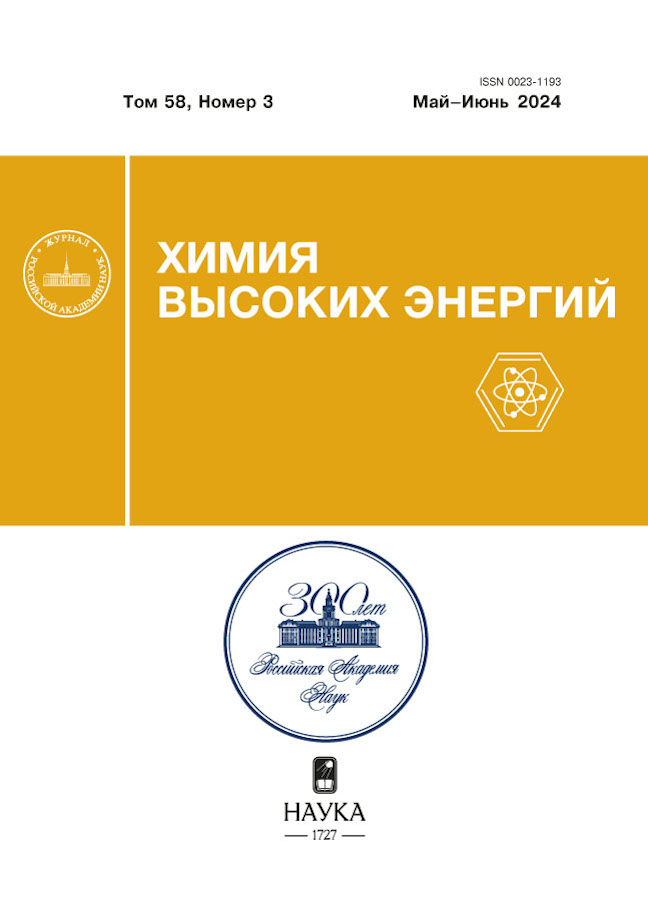On Specific Quenching of Tb3+ Ions Radioluminescence in Aqueous Solutions by Hydrogen Atom
- Authors: Sharipov G.L.1, Abdrakhmanov A.M.1, Gareev B.M.1, Yakshembetova L.R.1
-
Affiliations:
- Ufa Federal Research Center of the Russian Academy of Sciences
- Issue: Vol 58, No 3 (2024)
- Pages: 203-208
- Section: RADIOLUMINESCENCE
- URL: https://rjraap.com/0023-1193/article/view/661345
- DOI: https://doi.org/10.31857/S0023119324030049
- EDN: https://elibrary.ru/UUQAWT
- ID: 661345
Cite item
Abstract
The influence of acceptors of the water radiolysis primary products of the H atom and ea–q on the spectra and intensity of the Tb3+ ion radioluminescence and photoluminescence in aqueous solutions of TbCl3 and Tb(NO3)3 is considered. The activation effect of Tb3+ radioluminescence in the presence of H acceptors was revealed, indicating the presence of a specific quenching reaction (Tb3+)* by this radiolysis product, inhibited by its acceptors. An increase in activation was found in the joint presence of H and hydrated electron acceptors in the solution; for acceptors of the latter, a similar activation effect of Tb3+ radioluminescence was established earlier.
Full Text
About the authors
G. L. Sharipov
Ufa Federal Research Center of the Russian Academy of Sciences
Email: abdr-73@ya.ru
Russian Federation, Ufa
A. M. Abdrakhmanov
Ufa Federal Research Center of the Russian Academy of Sciences
Author for correspondence.
Email: abdr-73@ya.ru
Russian Federation, Ufa
B. M. Gareev
Ufa Federal Research Center of the Russian Academy of Sciences
Email: abdr-73@ya.ru
Russian Federation, Ufa
L. R. Yakshembetova
Ufa Federal Research Center of the Russian Academy of Sciences
Email: abdr-73@ya.ru
Russian Federation, Ufa
References
- Kazakov V.P., Sharipov G.L. Radioluminescence of aqueous solutions. M.: Nauka, 1986. 136 p.
- Seregina E.A., Seregin A.A., Tikhonov G.V. // High Energy Chem. 2014. V. 48. P. 440; https://doi.org/10.7868/S0023119714060118
- Poluektov N.S., Kononenko L.I., Efryushina N.P., Beltyukova S.V. Spectrophotometric and luminescent methods for the determination of lanthanides. Kiev: Naukova Dumka, 1989. 256 p. (in Russian).
- Kukinov A.A., Balashova T.V., Ilichev V.A. et al. // Phys. Chem. Chem. Phys. 2019. V. 21. P. 16288; https://doi.org/10.1039/C9CP03041G
- Cooper D.R., Capobianco J.A., Seuntjens J. // Nanoscale. 2018. V. 10. P. 7821; https://doi.org/10.1039/C8NR01262H
- Seregina E.A., Dyachenko P.P., Tikhonov G.V. // Proc. of 14 Int. Conf. on Ion Beam Analysis / VI Europ. Conf. On Accelerators in Applied Research and Technology. Nuclear Instruments and Methods in Physics Research (NIM) B. 2000. P. 161–163.
- Kilin S.F., Rozman I.M. // Optika i spektroskopiya. 1963. V. 15. № 4. P. 494 (in Russian).
- Stein G., Tomkiewicz M. // Trans. Faraday Soc. 1971. V. 67. P. 1678; https://doi.org/10.1039/TF9716701678
- Sharipov G.L., Kazakov V.P. // Russ. Chem. Bull. 1979. V. 28. P. 239; https://doi.org/10.1007/BF00925442
- Sharipov G.L., Gareev B.M., Abdrakhmanov A.M., Yakshembetova L.R. // Izvestia Ufimskogo Nauchnogo Tsentra RAN. 2021. № 4. P. 22 (in Russian); https://doi.org/10.31040/2222-8349-2021-0-4-22-29
- Pikayev A.K., Shilov V.P., Spitsyn V.I. Radiolysis of aqueous solutions of lanthanides and actinides. M.: Nauka, 1983. 240 p. (in Russian).
- Weller A., Zachariasse K. // J. Chem. Phys. 1967. V. 46. P. 4984; https://doi.org/10.1063/1.1840667
- Kavarnos G.J., Turro N.J. // Chem. Rev. 1986. V. 86. P. 401; https://doi.org/10.1021/cr00072a005
- Shiery R.C., Fulton J.L., Balasubramanian M. et al. // Inorganic Chem. 2021. V. 60. P. 3117; https://doi.org/10.1021/acs.inorgchem.0c03438
- Buxton G.V., Greenstock C.L., Helman W.P., Ross A.B. // J. Phys. Chern. Ref. Data. 1988. V. 17. P. 513; https://doi.org/10.1063/1.555805
Supplementary files













